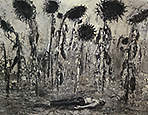
|
|
Feb. 11, 1997
|
Art Watch Index - Feb. 4, 1997
![]()
<<I HOLD ALL INDIAS IN MY HANDS>>

The orders of night, 1996
Anselm Kiefer http://www.broadartfdn.org/ bio-kiefer2.html
Anselm Kiefer - Reference Page
Chris De Witt's Berlin Wall Web Page
Time & Again - Berlin Wall
Vincent Van Gogh: A Tribute
Vincent van Gogh
Vincent van Gogh
Philadelphia Museum of Art |
Anselm Keifer of the New Age
Some may be baffled to hear the title, "The New Works by Anselm Keifer". The name, "Keifer", may provoke an emotion close to an obsession for anyone who has been in touch with the art world in the '80's. Despite this fact, the name, "Keifer", also sounds like a distant event in history. Many may even carry the question, "Did Keifer still exist?", in their minds. Such a statement may sound rude to a person who was born in the year World War II ended, and is still too young to be referred to as an elderly. At any rate, Keifer is back. At the Anthony d' Offay Gallery and the South London Gallery located at a slight distance from the center of London, Keifer is holding two exhibitions presenting his new works after a long while. After the dramatic fall of the Berlin wall, Keifer left Germany, and moved to New York, travelling around Latin America, India and Austria, and eventually finding a home in a village close to Arles, in the southern part of France where van Gogh used to live. The exhibition displays his new works painted at this place. His style remains the same, with thick layers of paint painted on a huge canvas. The '80's, the age of Keifer The '80's was the age of Keifer. My first encounter with Keifer's works was ten years ago in 1987, when the large-scale retrospective came to the Philadelphia Museum of Art. It is probably unnecessary to refer to the impact this retrospective in the United States had on the art scene. The art scene of the '80's in America, which saw the transition from Neo-Expressionism, to Neo Geo, and to Simulation Art, which occurred in line with the market expectations, failed to create a "master" in the end. Then came along Keifer from Germany, with his huge painting that was over 3 meters tall, the thickly layered painted canvas, and the grand themes of the spiritual history of Germany, referring to motifs such as the myths, war, and fascism. These aspects were considered enough to revive the concept of the almost forgotten idea of a "master" in the art scene. Could Keifer have been the last painter? Was Keifer kitch? However, the collapse of the Berlin wall changed the assessment of Keifer. With the unification of East and West Germany, the aesthetics of Keifer's thickly painted canvas was exposed as an ideological product, similar to the Berlin wall, which collapsed overnight like a thin "backdrop". In 1993, when the first full-scale exhibition of Keifer was held at the Saison Art Museum in Japan, the Japanese academics argued over whether or not "Keifer was kitch", and this was a product of the fall of Keifer's evaluation. I do not take the opinion that "Keifer was originally not a great artist". Only when the wall came down, people understood that the wall was destined to crumble. We must not forget that before such a downfall, the wall functioned realistically as an overwhelming political power. Thus, we must not underestimate the fact that similarly, Keifer's painting did have a certain "materialistic power" under the Cold War structure. Keifer representing the New Age Nevertheless, Keifer was an artist of the '80's. More correctly, we cannot help but conclude that he was an artist who consequently came to an end together with the fall of the Berlin wall. Unfortunately, this exhibition seems to have confirmed that fact. The huge canvas and his technique of controlling it has not changed since the '80's. What has definitely changed is the motif. With the brushstrokes he used to express German history before, he now paints the sunflower, a flower van Gogh adored, and a man is shown lying down in a Yoga pose at the root of the flower. On the canvas, real sunflower seeds are scattered. His theme of capturing life and death, and reincarnation, still remains to be grand, but because of the grand nature, his work seems empty and even awkward. Contrary (or in addition) to the serious style of painting, it is hard to take the implementation of Oriental spiritual history, such as the Yoga, in a serious way. If this overly German artist, who suffers from a type of identity crisis after the fall of the Berlin wall, had discovered his temporary, new identity in this New Age-like world, that is pathetic. Of course, he may have understood from the beginning that whatever he presented, there would be criticism. However, even if this were some kind of irony to forestall the criticism, it seems to be of bad taste on his part.
[Yoshitaka MOURI/Culture Studies]
|
|
|
|
|
|
|
|
|
Feb. 11, 1997
|
[home]/[Art Information]/[Column]
Copyright (c) Dai Nippon Printing Co., Ltd. 1997
Network Museum & Magazine Project / nmp@nt.cio.dnp.co.jp